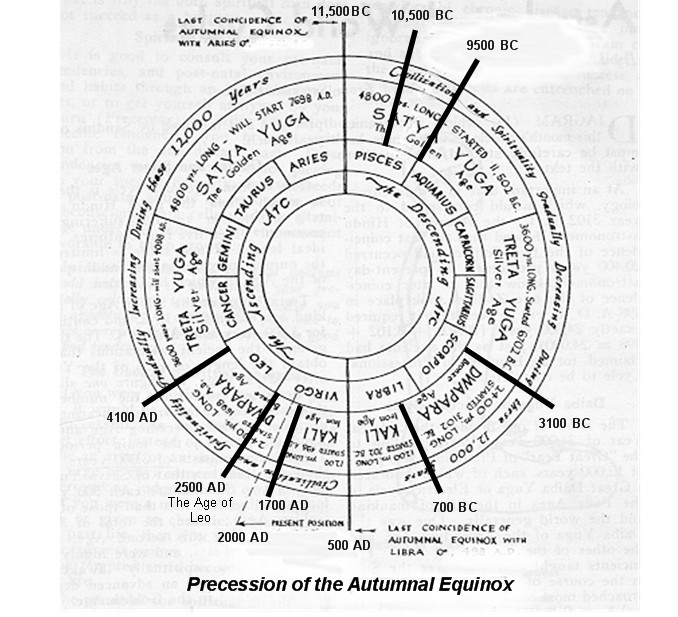Kali Yuga length confused with the
Ancient Atlantean Cycle
by
Laurie Pratt
(Tara Mata)
(excerpted from "Astrological World Cycles" November, 1932)
Introduction
There are cycles within cycles—cycles of inconceivably long as well as of unimaginably short duration. It is not, therefore, my aim to contend that the cycle (rather, half-cycle) of 4,320,000 years (Mahayuga or Manvantara) which the Kali Yuga scholars brought into prominence, has no basis in fact. In truth, a solar cycle of that length is recorded in ancient Hindu almanacs as having been preserved from the chronological compilations of a great astronomer-astrologer, Asuramaya, but I do wish to point out that, whatever the astrological import of the 4,320,000 year cycle, it should not be confused, as it has been since the dark days of Kali Yuga of the Descending Arc, with the Equinoctial 24,000 year Cycle with its two sets of four World Ages.
At that time a colossal mistake crept into the Hindu almanacs and has been blindly perpetrated ever since. Reference to the Diagram below will show that the year 700, B.C., marked the completion of Dwapara Yuga, and the beginning of Kali Yuga, of the Descending Arc.

The Maharajah Judhisthir, who began to reign in India during the latter years of the Dwapara era, voluntarily gave up his throne to his grandson, Raja Parikshit, shortly before the start of Kali Yuga, and retired with all the wise men of his court to a religious retreat in the Himalaya Mountains. Thus, there were none left, at the grandson’s court, sufficiently versed in the ancient wisdom, to calculate the Ages correctly.
So, when the last year of the 2,400 year period of Dwapara Yuga passed away, and the first year of the 1,200 year Kali Yuga dark Age had arrived (in 700BC), the latter was numbered as the year 2401 instead of year 1 of Kali Yuga. In 498, A.D., when the 1,200 year period of Kali Yuga of the Descending Arc had been completed, and the first year of Kali Yuga of the Ascending Arc began, the latter was designated, in the Hindu almanacs, as the year 3601 instead of year 1 of Kali Yuga of the Ascending Arc.
.
Solar Years Become "Divine" Years
However, as the wise men of that period were well aware, from conditions in India and the world generally, that mankind was in Kali Yuga, the dark Iron Age of Necessity, as described in the prophecies in the Mahabharata, their sacred teachings, and as they also knew that, according to these same scriptures, the age of Kali was fixed at 1,200 years only, they fancied, by way of reconciliation between the scriptures and their current almanacs, that the 1,200 years of Kali were not the ordinary solar year of our earth, but "Divine" years of the gods, consisting of 12 Divine months of 30 Divine days. Each of these Divine days was supposed to be equal in length to one of our solar years.
Thus, the Sanskrit scholars of Kali Yuga, such a Kullu Bhatta, explained away the discrepancies in their almanacs, saying that the 1,200 years allotted by the ancients for the duration of one Kali Yuga were equal (1,200 x 360) to 432,000 solar years of our earth, and that, in 498, A.D., 3,500 years of this long Kali Yuga had passed away. Thus the mistaken calculation gained firmer ground in Hindu chronology, and today the almanacs used in India state that the present year (1932) is the 5,034th of Kali Yuga, of which 426,966 years still remain.
Equinoctial Cycle Disregarded
By thus expanding the 1,200 year period into 432,000 solar years, the Kali Yuga teachers entirely lost sight of the connection of the Yugas with the 24,000 year Equinoctial Cycle, and the key to the correct calculation of the World Ages was lost. A modest 24,000 year period is well within the grasp both of the human mind and of historical annals and prehistoric records, but who can hope to trace the characteristic outlines of the two sets of Four Yugas in the affairs of mankind for a period of 8,640,000 years (24,000 x 360)?
No such difficulty faces us if we seek the evidence of the various World Ages in a 24,000 year cycle, and enough is known of the history of mankind for the past 7,000 years (which, rightly, covers our historical period) to enable us to clearly trace the distinctive influence on world events of the various Yugas which have, either completely or partially, run their course during that 7,000 year span.
Mistaken Expansion of Cycle
The erroneous computations of the Four Ages, given out by the Kali Yuga scholars when they discovered their chronology was not in keeping with the rules laid down by the ancient rishis, are as follows:
Satya Yuga, 4,800 X 360 = 1,728,000
Treta Yuga, 3,600 X 360 = 1,296,000
Dwapara Yuga, 2,400 X 360 = 864,000
Kali Yuga, 1,200 X 360 = 432,000
Total Mahayuga in Solar Years, 4,320,000
No justification exists in the Mahabharata, or in the teachings of Manu, for this transformation of solar years into "Divine" years in reference to the Four Ages of the Equinoctial Cycle, yet these mistaken expanded figures have been accepted, without due investigation, not only by the mathematicians who compile the almanacs in present-day India, but also by writers of standard metaphysical and astrological textbooks. These authors have erected, on this shaky mathematical foundation, elaborate cosmological structures which will not stand the test of astronomical verification.
The 12,000 year period, which loses its intrinsic significance when turned into 432,000 years, was known to all ancient civilizations as the half of an Equinoctial Cycle. The old Mazdeans (Magi, of whom the modern Parsis are descendants) had a 12,000 year cycle, Zervan Daregho Hyadata ("Sovereign Time of the Long Period.") With the Greeks and their instructors, the Egyptians, the "Great Age" again referred only to the tropical or sidereal year of the Equinoctial Cycle.
![]()
![]()